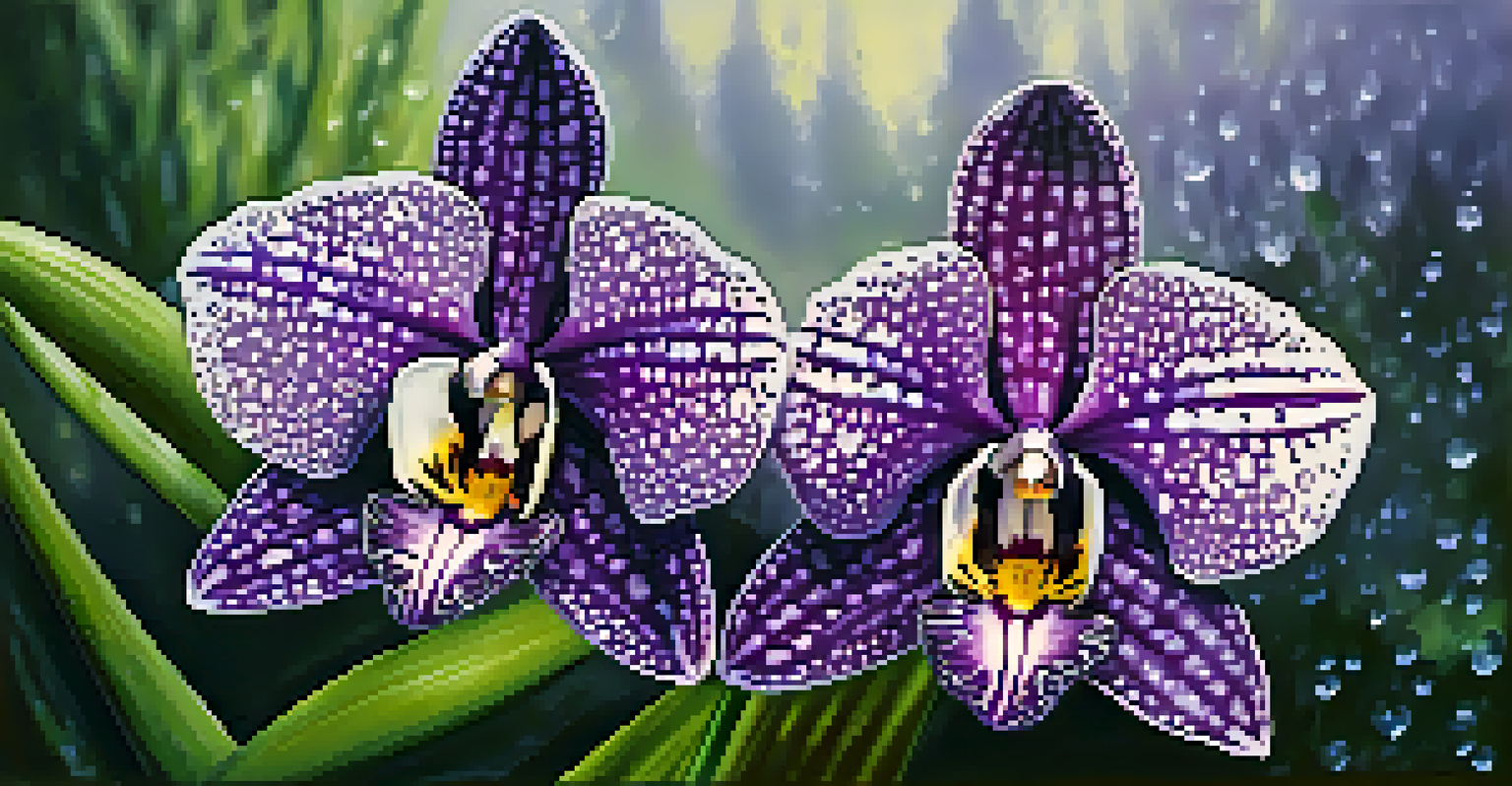Exploring the Vibrant Flora of Western Ghats in India

An Introduction to the Western Ghats: A Biodiversity Hotspot
The Western Ghats, a UNESCO World Heritage site, stretch along the western coast of India, offering a breathtaking landscape filled with lush greenery. This mountain range is not just a feast for the eyes; it's a biodiversity hotspot that houses a rich variety of flora and fauna. With over 7,402 species of flowering plants, it represents one of the world's eight 'hottest hotspots' of biological diversity.
The Western Ghats are among the world's eight 'hottest hotspots' of biological diversity.
The region's unique climate and geography create a perfect environment for an array of plant species, many of which are endemic—meaning they are found nowhere else on Earth. From tropical rainforests to grasslands, the Western Ghats' varied ecosystems support a remarkable range of vegetation. This variety is crucial for sustaining the local wildlife and maintaining ecological balance.
Exploring the flora of the Western Ghats is not just about appreciating beauty; it's also about understanding the complex relationships between different species. Each plant plays a vital role in the ecosystem, contributing to soil health, water conservation, and even climate regulation.
The Unique Plant Species of the Western Ghats
Among the rich tapestry of plant life, several species stand out due to their unique characteristics and ecological importance. For instance, the iconic Nilgiri Tahr is often associated with the region, but it is the native shola forests that truly capture one’s imagination, with their dense, evergreen trees and vibrant undergrowth. These forests are home to many rare plant species, including the endangered Vanda tessellata, a stunning orchid.

Another remarkable plant is the giant Raintree, known for its expansive canopy that provides shade to various underbrush species. Its wide branches and delicate flowers are a sight to behold, serving as a vital habitat for numerous birds and insects. These interactions highlight the interconnectedness of life within the Western Ghats.
Western Ghats: A Biodiversity Haven
The Western Ghats are recognized as a UNESCO World Heritage site, housing over 7,402 species of flowering plants, making it one of the world's most important biodiversity hotspots.
Additionally, the Western Ghats are renowned for their medicinal plants, many of which have been used in traditional healing practices for centuries. Plants like Ashwagandha and Tulsi are not only important culturally but also contribute significantly to the region’s economy through herbal medicine.
The Role of Endemism in the Western Ghats Flora
Endemism is a fascinating aspect of the Western Ghats, where many plant species have evolved to thrive in this specific environment. This evolutionary process has led to the development of unique adaptations that allow these plants to survive the region's diverse climatic conditions. For example, the Kurinji flower, which blooms once every 12 years, showcases this unique adaptation, drawing tourists and botanists alike.
Biodiversity is the foundation for ecosystem services to which human well-being is interlinked.
The presence of endemic species also signifies the health of the ecosystem, as these plants often rely on specific conditions to thrive. Protecting these species is crucial not only for maintaining biodiversity but also for preserving the ecological integrity of the region. Conservation efforts focused on these unique plants help to safeguard a living legacy for future generations.
Moreover, understanding endemism can provide insights into how climate change may impact these species. As temperatures rise and rainfall patterns shift, the survival of endemic plants becomes increasingly precarious, necessitating urgent conservation measures.
Conservation Challenges Facing Western Ghats Flora
Despite its rich biodiversity, the Western Ghats face significant threats from human activities, including deforestation, urbanization, and agriculture. These actions not only diminish the habitat available for native plants but also disrupt the delicate balance within the ecosystem. As forests are cleared for development, many endemic species find themselves without the specific conditions they need to survive.
Invasive species also pose a considerable threat, as they often outcompete native plants for resources. This competition can lead to a decline in native biodiversity, further exacerbating the challenges faced by conservationists. Efforts to manage and control invasive species are crucial to protecting the unique flora of the region.
Endemism and Conservation Importance
The region's unique endemic species, like the Kurinji flower, highlight the need for conservation efforts to maintain ecological balance and protect these vital ecosystems.
Community involvement and awareness are essential in tackling these conservation challenges. Local populations can play a pivotal role in preserving the flora by adopting sustainable practices and participating in conservation initiatives, ensuring that the rich plant life of the Western Ghats is safeguarded for generations to come.
The Impact of Climate Change on Plant Diversity
Climate change is a pressing issue that significantly impacts the flora of the Western Ghats. Changes in temperature and rainfall patterns can alter the delicate ecosystems, making it difficult for many plants to adapt. For example, certain species may find their suitable habitat shifting to higher elevations, leading to a loss of biodiversity at lower altitudes.
Additionally, the increased frequency of extreme weather events, such as floods and droughts, poses a further threat to plant life. These conditions can overwhelm the resilience of many species, particularly those that are already endangered or have limited distributions. The ripple effect of these changes can disrupt local wildlife that rely on these plants for food and shelter.
Addressing the impact of climate change requires a concerted effort from governments, scientists, and local communities. By developing strategies that enhance ecosystem resilience, we can help protect the unique flora of the Western Ghats while also mitigating the effects of climate change.
Eco-Tourism: A Path to Conservation
Eco-tourism in the Western Ghats has emerged as a promising avenue for conservation and awareness. By promoting responsible travel, it helps fund conservation efforts while providing visitors with a chance to experience the region's incredible flora firsthand. Travelers are often drawn to the stunning landscapes and unique plant species, and their presence can support local economies.
Guided tours and educational programs can foster a deeper appreciation for the Western Ghats' biodiversity, encouraging tourists to engage with conservation efforts. For instance, nature walks through lush forests allow visitors to witness rare plants and learn about their ecological significance, cultivating a sense of stewardship.
Eco-Tourism: Supporting Conservation
Eco-tourism in the Western Ghats offers a sustainable way to fund conservation initiatives while raising awareness about the region's rich plant diversity.
However, it's essential that eco-tourism is managed sustainably to prevent overexploitation of resources. By balancing tourism with conservation, we can ensure that the vibrant flora of the Western Ghats continues to thrive while also providing an enriching experience for visitors.
Conclusion: The Importance of Preserving Western Ghats Flora
The Western Ghats are not just a geographical marvel; they are a vital ecological treasure trove that deserves our attention and protection. The diverse flora found within this region plays a crucial role in maintaining ecological balance, supporting wildlife, and providing resources for local communities. As we explore this vibrant landscape, we must recognize our responsibility to protect it.
Conservation efforts are essential to preserving the unique plant species and their habitats. By raising awareness about the importance of biodiversity and supporting sustainable practices, we can contribute to the ongoing efforts to safeguard the Western Ghats. Every small action counts, whether it’s participating in local conservation programs or simply spreading the word about the beauty of this region.

In conclusion, the flora of the Western Ghats is a reminder of nature's beauty and resilience. By working together to protect this biodiversity hotspot, we can ensure that future generations will also have the opportunity to marvel at its vibrant plant life and the vital ecosystems it supports.